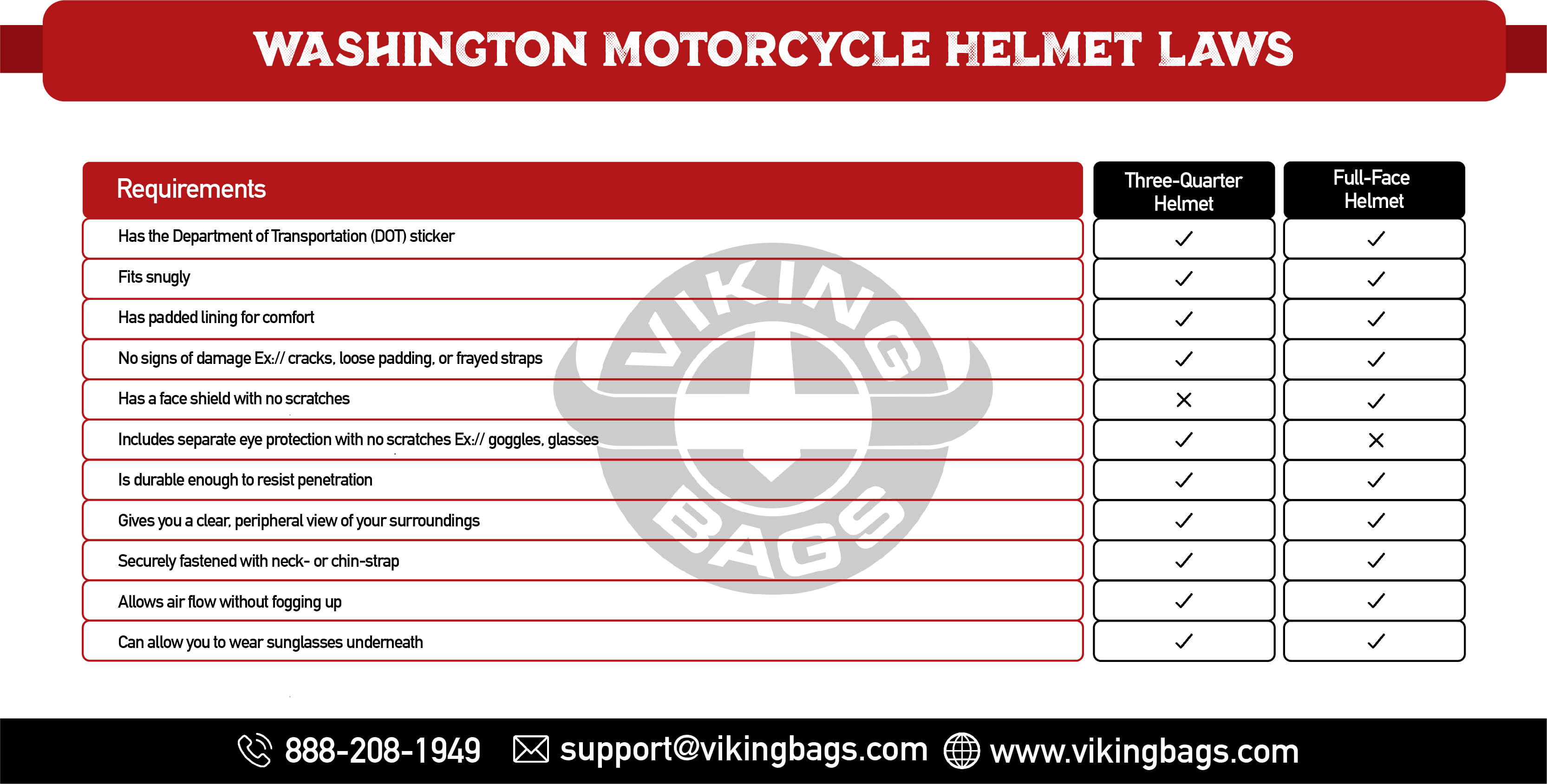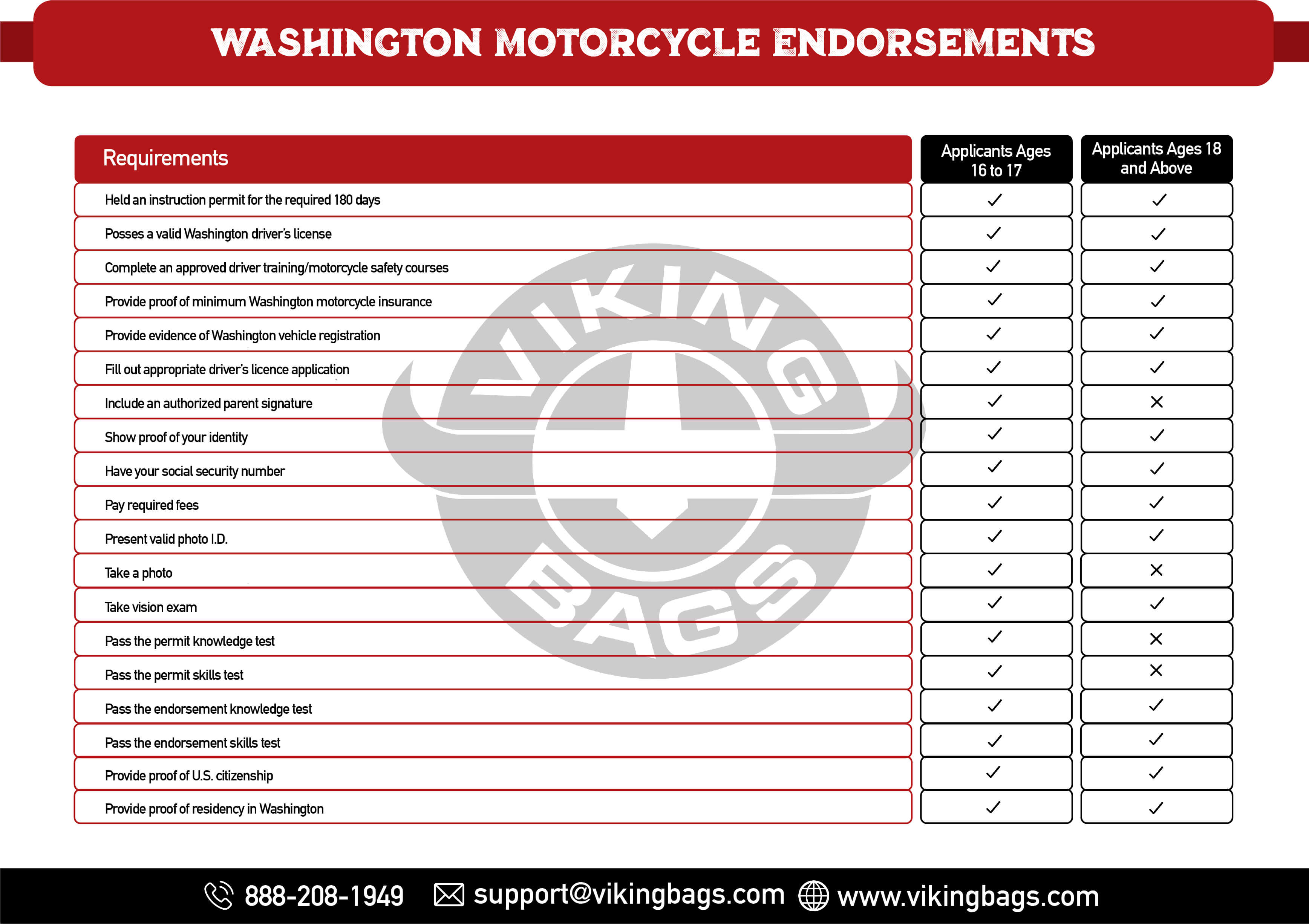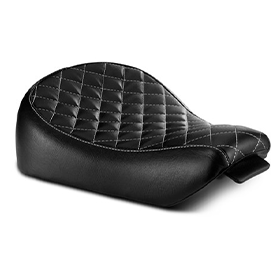- Table of Contents
- 1. Introduction
- 2. Washington Motorcycle Insurance
- 2.1 Washington Motorcycle Helmet Laws
- 2.2 Washington Motorcycle License Laws
- 2.3 Requirements for Washington Motorcycle Instruction Permits
- 2.4 Requirements to Apply for Washington Motorcycle Endorsements
- 2.5 Washington Motorcycle License Test
- 2.6 Washington Motorcycle Passenger Laws
- 2.7 Washington Motorcycle Lane Splitting Laws
- 3. Washington Motorcycle Safety Features
- 4. Washington Motorcycle Exhaust Noise Laws
- 5. Takeaway
1. Introduction
When people typically use the word “Washington,” they are referring to the capital city of the United States. However, the state of Washington is equally deserving of recognition and praise. Especially from motorcyclists who are looking for a great setting to practice their riding skills and wish to explore the region on their favorite vehicle.
Called “The Evergreen State” due to being covered by endless evergreen forests, Washington does not just provide natural scenery for riders to enjoy. Its many roads travel high up through the mountainous areas and glides low alongside the coast near the Pacific Ocean.
Traveling through Washington can be a fun adventure, but you have to know what is considered appropriate motorcycle behavior to make the most of it. It is possible to enjoy a trip through Washington while complying with the motorcycle traffic laws. Also, you may need to earn qualifications that allow you to legally operate a motorcycle in Washington.
This article will teach you about motorcycle laws and licensing in Washington as of 2021.
2. Washington Motorcycle Insurance
According to Revised Code of Washington § 46.30.020., it is mandatory for all motorcyclists in Washington to own motorcycle liability insurance. They must also carry documentation showing proof of ownership whenever they are operating their vehicles.
You should carry Washington motorcycle insurance that covers the minimum liability coverage for the following:
- $25,000 for bodily injury for one person per accident
- $50,000 for bodily injuries of multiple people per accident
- $10,000 for property damage per accident
- While you are required to have Washington motorcycle insurance that covers most accident-related fees, you should not settle for the bare minimum. To prevent financial risk in case you get stuck paying off lots of damages and medical bills, you will need to acquire other forms of coverage.
- Personal Injury Protection or PIP will help pay for any medical and funeral expenses accrued due to an accident. This form of coverage comes with its own minimum costs such as:
- $10,000 for medical expenses per person injured in an accident
- $2,000 for funeral expenses
Underinsured or uninsured coverage is useful to have if you are dealing with an at-fault driver who either does not own insurance or has insurance that cannot provide full compensation. This could also be handy if you are injured in a hit-and-run.
If you need to refresh your memory on the provisions related to Washington motorcycle insurance, you can find a section of the Washington State Legislature.
2.1 Washington Motorcycle Helmet Laws
As stated in the Revised Code of Washington § 46.37.530., all motorcyclists regardless of age are required to wear an approved motorcycle helmet while their vehicle is in motion. The general description for a motorcycle helmet is that it needs to have a hard outer shell, padding in between the exterior and interior and a grip around your neck or ching to keep it in place.
The motorcycle helmet has to meet the standards set by the Washington State Patrol. It also has to satisfy the requirements set by the Department of Transportation.
In order to comply with the Washington motorcycle helmet laws, you need to make sure that you pick a motorcycle helmet that has the following features:

If you would like to read the regulations regarding Washington motorcycle helmets, go and visit this section of the Washington State Legislature.
2.2 Washington Motorcycle License Laws
2.3 Requirements for Washington Motorcycle Instruction Permits:
Before you can get into situations where you will need to use your Washington motorcycle insurance and motorcycle helmet, you have to earn a motorcycle license that allows you to operate in Washington.
For it to be legal for you to ride a motorcycle in Washington, you are required to own a Washington driver’s license with a two-wheeled motorcycle endorsement or a three-wheeled motorcycle endorsement.
But before you can receive a motorcycle endorsement, you first need to apply for the instruction permit for either a two-wheeled or three-wheeled motorcycle. Below are the requirements and restrictions placed:

2.4 Requirements to Apply for Washington Motorcycle Endorsements:
After you have finished practicing on your vehicle within the time your motorcycle instruction permit was valid, you are ready to move on and apply for your motorcycle endorsement.
Depending on your age and the type of vehicle you possess, the requirements for receiving a two-wheeled or three-wheeled motorcycle endorsement may differ. This chart will help narrow down what you need to do when going through the application process:

When paying for a Washington motorcycle instruction permit, you will have to provide $15. If you wish to renew it, you will have to pay another $15.
To complete the required education courses, you will have to pay a fee of $40 if you are under the age of 18 or $125 if you are 18 years old or older.
When you finally pay to get your Washington motorcycle endorsement, the bill can range from $17 to $27.
If you wish to review the checklist of requirements when applying for Washington motorcycle instruction permits or endorsements, visit the Washington State Department of Licensing.
2.5 Washington Motorcycle License Test:
For the written portion of the Washington motorcycle license test, the permit knowledge test is 25 multiple choice questions. Meanwhile, the endorsement knowledge test has 50 multiple choice questions. You need to get a passing grade of 80% for both of them. They will test how well you have memorized the rules of the road and general motorcycle safety.
If you are getting an endorsement for your three-wheeled motorcycle, the written portion will only have 25 questions and additional questions may be asked specific to the capabilities of three-wheeled motorcycles.
For the riding portion of the Washington motorcycle license test, both the permit and endorsement versions will be an assessment of your riding skills as you demonstrate specific maneuvers within a controlled environment. Examples of riding maneuvers you will have to demonstrate include:
- Cone weaving
- Braking normally
- Obstacle swerving
- Quick stops
- Curving
Another option for getting your Washington motorcycle license is to complete an approved motorcycle safety course at a designated Washington motorcycle training school. As the classes involve learning motorcycle knowledge and riding information, this will allow you to bypass taking the tests. Present proof of completion and you should be able to receive your motorcycle license.
If you wish to review the testing process for getting a Washington motorcycle license, check out the Motorcycle Operator Manual: Two- and Three-Wheel provided by the Washington Department of Licensing.
2.6 Washington Motorcycle Passenger Laws
You are not allowed to carry a passenger on your motorcycle that is below the age of five. You are also not allowed to carry any passengers if your motorcycle is not outfitted with the right equipment to transport another person.
Your motorcycle must fix a second seat, saddle, or sidecar designated solely for a passenger. You cannot try to fit two or more people onto a seat designed for only one person. There must also be footsteps or pegs that your passenger must keep their feet planted on while the vehicle is in motion.
Your passenger is required to wear a motorcycle helmet that will satisfy conditions set by both the Washington State Patrol and Department of Transportation.
Your passenger has to keep both feet on opposite sides of the motorcycle. He/she cannot sit sideways so that both feet are resting on just one side.
If you have a single passenger and a sidecar, your passenger is required to sit in it to prevent your motorcycle from experiencing weight imbalance. If you have two passengers, the heavier passenger should sit in the sidecar while the lighter passenger should sit in the passenger seat near the rear end.
2.7 Washington Motorcycle Lane Splitting Laws
As made clear in Revised Code of Washington § 46.62.608., no motorcyclists are allowed to ride in between lanes or in between rows of vehicles slowed or stopped in traffic. In other words, Washington is one of the few states that officially declares lane splitting as illegal.
If you are caught attempting to do lane splitting, you can be fined at least $136. You can also be charged with reckless driving, illegal passing, and other traffic violations by local law enforcement.
If you wish to know the proper behavior for operating a motorcycle on the road, you can read this section of the Washington State Legislature .
3. Washington Motorcycle Safety Features
Even if you are being extra careful to follow Washington’s rules of the road, you can still get pulled over by the local law enforcement if you fail to notice that your motorcycle is not functioning properly.
Whenever you operate your motorcycle, it needs to have good visibility so that you can see incoming danger and other drivers can see you.
You also have to be able to relay your presence using either your lights or horn from a distance.
The components that work in cohesion to keep your motorcycle running smoothly have to be kept in good shape to prevent mechanical failure in the middle of busy traffic.
Whenever you conduct a periodic safety inspection of your motorcycle, you should examine and provide maintenance to the following parts:
- Wheels (2 to 3)
- Electric or fuel motor
- Windshield (if applicable)
- Handlebars (Can only be elevated 30 inches above the seat)
- Brake system
- Controls
- Headlight
- Tail light
- Brake light
- License plate light
- Rear red reflector
- Turn signals (required for models after 1960)
- Tires
- Horn
- Mufflers
- Rearview mirrors
- Fenders
- Speedometer
If you would like an overview of motorcycle equipment requirements, you can find the checklist on the Motorcycle Resource Sheet provided by the Washington State Patrol.
4. Washington Motorcycle Exhaust Noise Laws
Laid out in Revised Code of Washington § 46.37.537., no motorcyclist is allowed to operate a vehicle that does not have a muffler attached. A motorcyclist also cannot make any modifications to the muffler which could potentially increase the volume of the noise emitted from the exhaust.
If you take a look at Washington Administrative Code § 173-62-030, the decibel limit for exhaust noise differs based on the model year of the motorcycle.
For motorcycles manufactured after 1980, the exhaust noise should be below 78 decibels when moving at or less than 45 miles per hour. The exhaust noise should be below 82 decibels when moving faster than 45 miles per hour.
For motorcycles manufactured before 1986, the exhaust noise should be below 99 decibels when measuring from 20 inches away.
For motorcycles manufactured after 1976 to 1986, the exhaust noise should be between 80 to 83 decibels when measuring from 50 inches away.
If you wish to review the policy for motorcycle exhaust systems, you can read this section of the Washington State Legislature .
Also, if you would like to review the specific decibel limits and ranges for motor vehicles, you can find it also at the Washington State Legislature .
5. Takeaway
Riding a motorcycle in Washington can be a thrill, but you should never forget that caution is more important than fun. If you are not mindful of your motorcycle and your surroundings, you might find yourself getting yourself into trouble with other drivers you run into or local law enforcement who interpreted your style of riding as reckless.
Before you even take your motorcycle out on the Washington roads, you need to make some preparations. Having Washington motorcycle insurance will help you keep your finances safe even if unexpected accidents occur that affect your health or the condition of your motorcycle. An approved motorcycle helmet will keep your head safe from harm even if you are thrown hard onto the ground.
Getting a Washington motorcycle license may take a while, but luckily the process is relatively simple. Depending on how old you are, you need to practice with the help of someone with more experience. Then you just have to pass the written and road tests to get your permit or endorsement. As long as you are diligent in your studies and intent on perfecting your riding skills, you will find getting a motorcycle license is not as hard as you thought.
When out on the road, you have to be mindful of motorcycle traffic laws. You cannot attempt lane splitting in any form unless you want to risk getting hit with a lawsuit. A passenger has to be older than a small child and work with you to make a motorcycle ride as smooth as possible. Your motorcycle has to have usable functions so you can make your presence known and react quickly to danger. It also has to be designed in a way that it will not be an inconvenience to other people sharing the road with you.
















Leave a comment
All comments are moderated before being published.
This site is protected by reCAPTCHA and the Google Privacy Policy and Terms of Service apply.